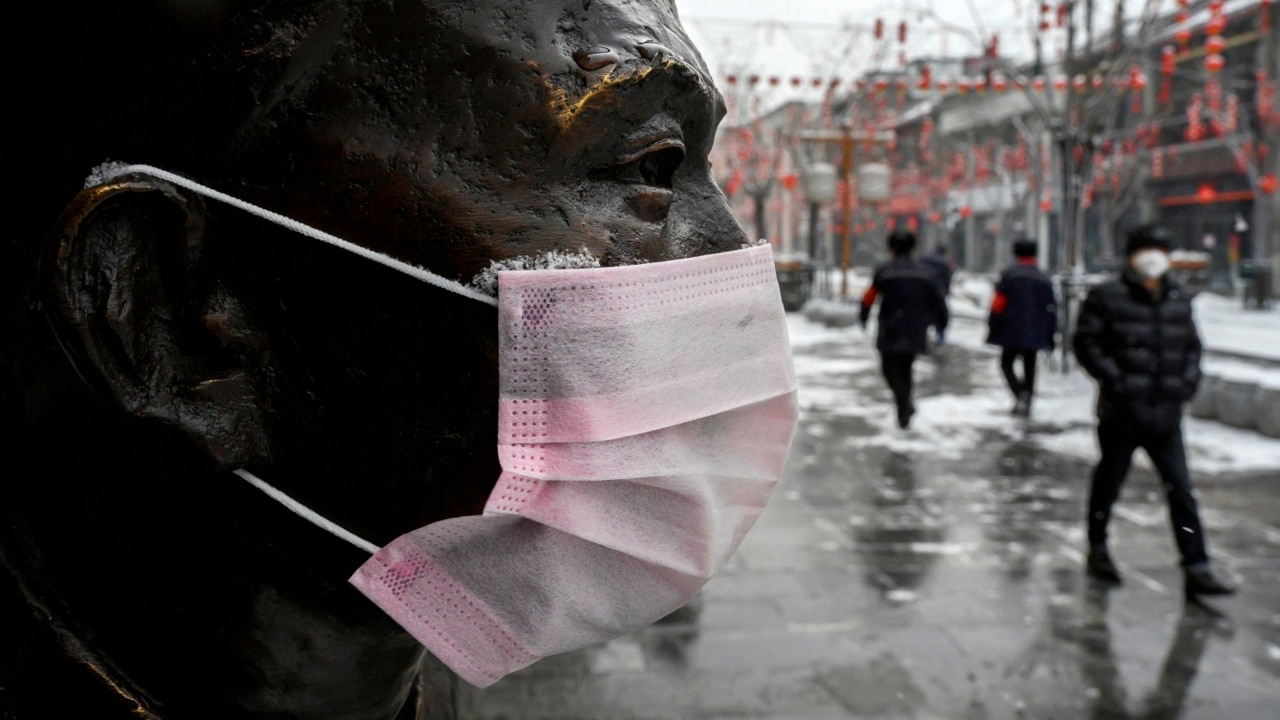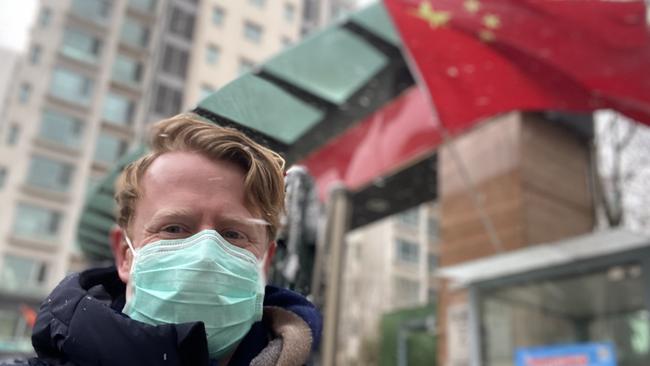Coronavirus: In silent city, fear hits too close to home
It is a notice nobody wants to find at their Chinese apartment compound right now.

It is a notice nobody wants to find at their Chinese apartment compound right now.
Three cases of the fast-spreading coronavirus — this week officially named COVID-19 — had been found in Sunshine City, a cluster of apartments neighbouring the Beijing compound I relocated to from Sydney three weeks before the World Health Organisation declared China the epicentre of an ongoing global health emergency.
“Residents, please don’t worry too much, let alone panic,” said the notice, posted outside the compound and passed around by residents over WeChat, China’s social media platform.
“Let us work together to prevent and control the epidemic scientifically … and create a healthy harmonious community atmosphere!” it finished patriotically, echoing phrases used by General Secretary Xi Jinping and his Chinese Communist Party propaganda team.
The three infected residents live in Sunshine City’s second tower, about 100m from my place, and had returned after a family Lunar New Year trip to Shanxi, a coal-producing province west of China’s capital.

A community neighbourhood committee put up the notice on Wednesday, the day after I went out for dinner with someone who lives in the compound. The good news is the three have been diagnosed as mild cases and, said the notice, they are recovering in hospital. The worrying news is that the family returned to my neighbourhood on January 30, almost two weeks before they were diagnosed with the highly infectious virus, which seems to have a fatality rate of about 2 per cent. I wonder if I ever passed them in our local supermarket.
No need to panic, sure.
But it’s the sort of lived experience that makes less abstract the huge numbers of confirmed cases of COVID-19, now at more than 64,000 after a huge spike in its epicentre in Hubei, following a change in how the central Chinese province measures cases.
Economic impacts
The coronavirus, and the extraordinary response to it, have closed down much of the world’s second-biggest economy.
And it’s initial botched handling by Hubei’s Communist Party — whose two most senior figures were on Thursday purged by Xi — has created an extraordinary political crisis in Beijing that, in less than three weeks, is scheduled to host the Communist Party’s biggest annual set piece, the National People’s Congress.
“The Chinese political system, in my judgment, sees this as the biggest crisis they have faced since Tiananmen,” said former prime minister Kevin Rudd this week.
With 1380 deaths and rising across Xi’s emerging superpower, Australia’s best-known Sinologist seems to have a point.
For Australian businesses — not to mention federal and state governments — hugely exposed to the Chinese market, it was an alarming sight. This week was supposed to mark China’s return to work after an extended Lunar New Year holiday. That was hard to believe as you looked around Guomao, the heart of Beijing’s CBD. “Less than 10 per cent of staff are back at work,” said one of the doormen at China World Offices, an enormous corporate tower complex near the party-controlled broadcaster China Central Television’s startling headquarters, which Beijingers call the “Underpants” building.

The foyer was empty except for a few security guards, a helmeted food delivery man and two people with thermometer guns — all wearing face masks, as is almost everyone in the country — waiting for someone to check.
A gilded tenant board of international and Chinese companies numbered a few from Australia, including industry superannuation giant AustralianSuper, which manages more than $160bn of Australians’ retirement money, and National Australian Bank, one of the big four. Both AustralianSuper and NAB are, like their superannuation and banking peers and much of the rest of the Australian economy, hugely exposed to China’s economy, which as the foyer of tower one at China World Offices suggests has mostly shut down.
Xia Han, 30, who works for a Chinese finance company, was a rare employee working in a CBD office. “I think this will last for at least one month,” Xia said through an N95 face mask, one of the chunky kind, which he now wears even at his desk.
Things were even quieter at the adjoining luxury shopping mall. Store after luxury store was empty, except for mask-wearing staff, many passing time cleaning shiny surfaces with cloths and buckets of disinfectant. Chanel: empty. Dior: empty. Celine: empty. Coach: closed.
Its CBD food court was just as grim. An Italian restaurant with a capacity of almost 200 had a single customer, wearing a mask and working on a laptop. Busiest was the Japanese restaurant. It had eight customers across its 40-odd tables. “Normally it would be full,” said the waitress, after taking my temperature and recording contact details. Bon appetit.
Hubei ‘terror’
Signs of the virus are all around Beijing. A fortnight ago temperatures began being checked on the metro, whose carriages have televisions play a looped video showing a man in a suit washing his hands, a lady putting on a mask and a highlights package of a hospital being built quickly.
This week those thermometer guns were being pointed at shopping centres. On Thursday night, I had mine checked when I went to pick up some beer.
Life in the capital — remarkably quiet for a city of 20-odd million — is eerie. But it’s nothing like the terror more than 1200km away in Hubei, the central province whose capital, Wuhan, is the epicentre of the virus.
While it has spread to at least 24 countries, COVID-19 remains very much a Chinese virus with international characteristics — at least in terms of the suffering it has caused. It is now more than three weeks since more than 50 million of the province’s citizens were put into lock down.
Flights from various international governments — first the US and Japan, and eventually Australia — evacuated their citizens.
There are no exceptions for Chinese nationals trapped in the province, which has had more than 51,000 cases and more than 1300 fatalities, more than 95 per cent of the global virus death toll.
Its hospital system — topped up at Xi’s instruction with another 2600 medical personnel from the People’s Liberation Army — is under extraordinary pressure.
Even Wang Shuang, star of the national women’s soccer team, was locked up in a Wuhan apartment as the team played an Olympics qualifier against the Matildas in Sydney on Thursday night. Will Wang — China’s Sam Kerr — be out before the Tokyo Olympics begin on July 24?
‘Just in case’
The Economist Intelligence Unit forecasts she will. Its team of economists predict a less than 5 per cent chance the virus will not be constrained by July. They dub that the “nightmare” scenario.
Much more likely — with a probability of 50 per cent, they estimate — is that the spread will be under control by the end of March. They give that a 50 per cent probability, which they estimate would reduce China’s economic growth for 2020 to 5.4 per cent, an extraordinarily low number by Chinese standards.
“Who can tell?” Duang Xiang, 55, says when asked how long he thinks it will last. The strawberry seller has more experience than most with these things. About 100m from where Duang is selling punnets — heavily discounted and still selling slowly — a flatpack hospital is being assembled.
Red flags with the logo of the state-owned Beijing Construction Group flutter on the walls around the site, surrounded by even more police guards than most buildings in the heavily guarded city.
A project manager says more than 1000 workers are on site, which is more flattened dirt and heavy machinery than hospital when I visit. It is scheduled to open by next week, as are similar quarantine hospitals around China — just in case.


To join the conversation, please log in. Don't have an account? Register
Join the conversation, you are commenting as Logout